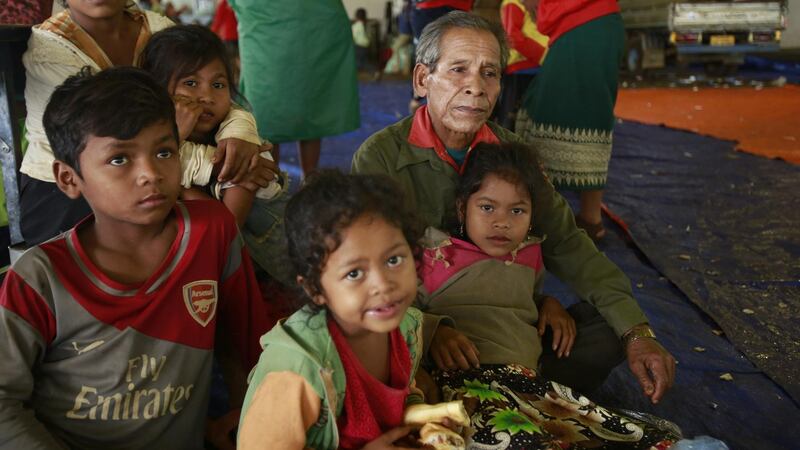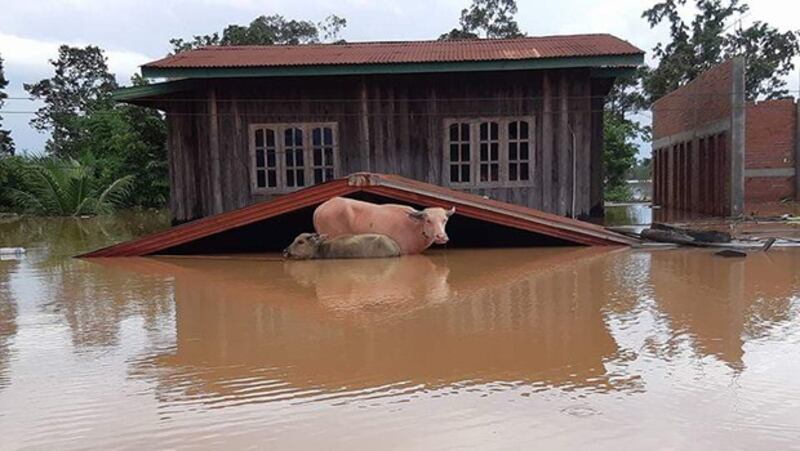Two years after a dam collapse that caused Laos’ worst flooding in decades, many of the thousands of rural villagers who lost their homes and land in the disaster say they are still struggling to recover with inadequate support from the dam’s developers and the Lao government.
On the night of July 23, 2018, billions of cubic feet of water from a tributary of the Mekong River poured over a collapsed saddle dam at the Xe Pian-Xe Namnoy (PNPC) hydropower project in southern Laos’ Champassak province, sweeping away homes and causing severe flooding in villages downstream in Attapeu province.
Cash-strapped Laos’ handling of the flood – which killed 71 people and displaced 14,440 when it wiped out all or part of 19 villages – has gotten mixed reviews among displaced villagers still waiting for or haggling over compensation.
Environmental and human rights NGOs, already critics of Laos’ ambitions to become the “battery of Southeast Asia” by building dozens of hydropower dams on the Mekong and its tributaries, are demanding government and corporate accountability and supporting the disaster survivors.
The government had promised to clear new land for farming and pay compensation for those displaced, but villagers in Attapeu say the help they have received has been slow in coming and short in substance – a situation shared by several thousand people whose claims remain unresolved.
“You want to talk about what we lack? We lack everything. We lack seeds and an irrigation system. What is the government going to do? Second, we have a lack of cattle, which we could use for food or sell as goods, like cows and sheep,” an affected villager, who requested anonymity for security reasons, told RFA’s Lao Service.
“We still don’t know what the government will do to reduce poverty for each affected family,” the villager from Attapeu’s Sanamxay district said.
The government began allocating land for those who lost theirs in the flood this year, offering one hectare (2.47 acres) to families with two members, two hectares for families of three, and three hectares for families of four or more.
A second villager told RFA that the plots are located in the hills without proper irrigation, but even if they were as fertile as the lands they had lost, the plot sizes are too small to grow enough rice to live on. Most villagers were rice farmers, and lack skills to find employment in other sectors.
“If villagers do not have fertile lowland rice paddy land, like before the dam broke, they will not be able to revive their livelihoods, because rice is their main food,” Ian Baird, a Southeast Asia expert at the University of Wisconsin-Madison, told RFA.

Insult to injury
Although the Lao government sees hydropower exports to Thailand and Vietnam as a way to boost the country’s economy, even before the July 2018 disaster, projects like Xe Pian-Xe Namnoy had become controversial for displacing villagers and destroying farmland, forests and fishing grounds.
Two years after the disaster, 12 villages in Sanamxay have been fully compensated, while seven are still owed compensation. Of the seven, three Sanamxay villages have accepted the government offer, while two others are demanding renegotiation.
Some villagers say they’ve suffered insult on top of financial injury when, after paying out half of their promised cash, officials announced that 20 percent of the total compensation would be taken out of future payments to cover paperwork, insurance, and a downward revaluation of loss claims to account for depreciation.
The second villager told RFA Monday that he never saw government officials visiting to explain the 20 percent deduction, and when he asked officials the reason for this revaluation of damage claims, they could not explain.
“We haven’t received it yet. We are afraid that the officials won’t give it to us because they have no money. Some villagers are getting paid, but others aren’t,” he said.
A third villager said local authorities called a meeting in his village to announce the deduction, but many disagreed.
“We are supposed to receive U.S. $5,000, but we’ll only get $3,000 after the deduction. It seems to be too low for us,” he said. “We want the full amount as initially agreed.”
A fourth villager told RFA, “All the villagers living here in the temporary houses are survivors. We couldn’t take anything with us when the dam broke. Some people got out with only their underwear.”
“It seems to be unfair if the remaining compensation money will be deducted by 20 percent. We felt very sad when we heard that our money would be deducted. We do not want to argue with the authorities, but we would like to call for their sympathy,” the fourth villager said.
Authorities in Attapeu province reached by telephone last week declined to comment on the deduction dispute, but Attapeu’s Deputy Governor Ounla Xayasith explained the deductions to RFA in May, saying that many of the claims included used items that had lost value due to depreciation.
‘Temporary’ lifestyle

Villagers told RFA that until they are compensated, they have no choice but to wait at relocation centers that lack sanitation and access to health care, housed in temporary shelters. They subsist on stipends paid out by the dam developers amounting to 250,000 kip (U.S. $27), and about 20 kilograms (44 pounds) of sticky rice per person per month.
But some of the villagers reported that they do not receive these stipends in a timely manner, and in some months not at all. The government has said that once compensation payments are complete, these stipends will stop.
A resident of Dong Bark village, who has been living in a temporary shelter, told RFA Tuesday, “I’ve gotten much poorer since the dam burst that destroyed my house and property. Now I live hand to mouth, and rely on foodstuffs provided by project developer. I have not received a living allowance since April.”
“I go back to the area of my former village [that was destroyed by the flood] to go fishing and collect forest materials,” he added.
“I have to cultivate rice near my former village, which is over 10 km (6.21 miles) away from the new resettlement area, but this year its productivity has decreased because of droughts,” he said.
The entire Mekong region suffered a drought long into what should have been the rainy season this year.
A resident of Thasengchanh village told RFA that he took it upon himself to leave the relocation center without the government’s help.
“I have moved out from my temporary shelter in order to live in the house I myself just built on my own farm land,” he said.
“I cannot live in the shelter because it is hot and, water leaks from roof when rains. As a result, so far the 50-60 families from Thasengchanh have moved out from the shelters,” he added.
The government and the dam developer have begun the process of building permanent houses and clearing land, but the houses will not be complete until 2021.
A dam official who requested anonymity told RFA that the company has been transparent about compensation, including the amounts of compensation and how it will be distributed.
No solution for ’10 or 20 years’

An anonymous source said that to date, for the five villages in Sanamxay, 700 houses have already been completed, including the necessary infrastructure like roads, health facilities and schools, at a cost of $24.5 million. On top of that, the Thai government built 45 more, and the Japanese government built 66 units.
An official from the Lao government told RFA that Vientiane has shored up dam safety standards, requiring developers to redesign their projects to international standards with early warning systems. Additionally developers are required to provide training for emergencies.
At a gathering to mark the second anniversary of the Xe Pian-Xe Namnoi disaster in Bangkok Thailand – the closest place to one-party Laos where such a gathering could be held -- NGOs said all parties involved needed to do better for the homeless villagers.
“Up until now, the responsible state personnel, companies, banks, and insurance companies that made these projects possible have failed to facilitate clear systemic channels by which affected people on both sides of the border can access compensation, reparations and regain livelihood dignity,” said the Laos Dam Investment Monitor (LDIM) in a statement.
“What we can see from this incident that we are worried about the most is that villagers are not receiving compensation and they need answers from all sectors involved,” Prem Rudee Dao Heung of LDIM told RFA.
Yuka Kiguchi from Mekong Watch Organization told RFA, “Over the past two years, for all the companies involved, we haven’t known clearly what they are doing to help the affected villagers. Companies and banks lack responsibility and transparency.”
Baird -- who lived in Laos for more than 15 years, and researches natural resource management, hydroelectric dams, and land concessions – said the farmers will not bounce back if they are given marginal land to replace rich lowlands lost to floods.
“Their livelihood problems will not be solved in 10 or 20 years if the issue of farmland is not seriously addressed,” he said.
The Xe Pian-Xe Namnoy dam is a joint venture that includes four companies from three countries. SK Engineering and Construction and Korea western power collectively have 51 percent stake in the project, while Thailand’s Rath Thai owns 25 percent and the Lao Holding state enterprise owns 24 percent.
Reported by RFA’s Lao Service. Translated by Sidney Khotpanya. Written in English by Eugene Whong.
